You are using an out of date browser. It may not display this or other websites correctly.
You should upgrade or use an alternative browser.
You should upgrade or use an alternative browser.
Article: DOC AUSTIN - Testing: Hi Tec's New HS5070MH Servos
- Thread starter rpstar
- Start date
Doc Austin
70cc twin V2
I've had a big couple of months with my various Edges. Please visit my blog and read all about it.
Here are a couple of Edge articles:
Video Showcase: 48" and 60" Edge EXP Bonanza
Extreme Flight 48" Edge EXP__Rediscovering The Classic .
Finally, it's been a long time since we shot a half speed video, mostly because they never seem to work unless something special is going on. In this case we had a spectacular sunset, coupled with the lovely soundtrack and slow hypnotic aerobatics. I am not often pleased with any of our videos, but this time I am going to allow myself to be satisfied.
Here are a couple of Edge articles:
Video Showcase: 48" and 60" Edge EXP Bonanza
Extreme Flight 48" Edge EXP__Rediscovering The Classic .
Finally, it's been a long time since we shot a half speed video, mostly because they never seem to work unless something special is going on. In this case we had a spectacular sunset, coupled with the lovely soundtrack and slow hypnotic aerobatics. I am not often pleased with any of our videos, but this time I am going to allow myself to be satisfied.
[video=vimeo;118100963]https://vimeo.com/118100963[/video]
Last edited by a moderator:
Doc Austin
70cc twin V2
Testing: Hi Tec's New HS5070MH Servos
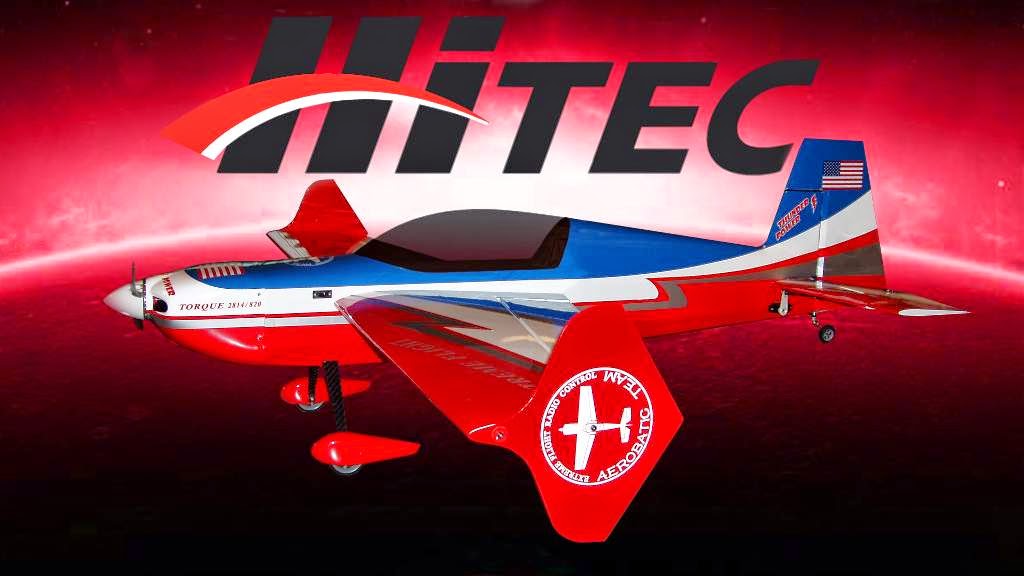
The Next Evolution
The 48" class plane seems to change and grow and preform more spectacularly every time a new airframe hits the market. I don't have the statistics, but it seems to me this is the most popular size electric (though the 60s are sure selling well). As a result, manufacturers keep updating and upgrading this class of airplane to the point that the performance is simply staggering.
First batteries got so good we needed better motors and then better ESCs, and then it was the EXP series that was the straw that broke the poor camel's back. The servos we were using had just become marginal because the airframes became so high performing.
For awhile now we have known we were on the cusp of outgrowing the beloved Hi Tec HS65MG we have been using on our 45-48 planes. Those servos served us so well for so many years, and it is still a damm good servo in it's proper application. For guys who don't relentlessly abuse the crap out of their EXPs, the 65MG will still be a good servo. It's only when you throw in the extreme abuse that the 65MG starts to suffer. For conventional aerobatics, 3D, and maybe even some lower intensity extreme aerobatics there is still nothing wrong with the 65MG at all. Also remember that the EXPs are extremely high performing airframes, and the 65MGs will still be fine in other brands of planes that do not put so much stress on the servos.
The funny part of the whole thing is the HS65MG was designed because we outgrew what we were getting from the HS55 servos, so this is a never ending cycle of airframe development being so insane that the rest of the gear struggles to keep up.
When the EXP series came out with their large control surfaces and outrageous deflections, that was the beginning of the end for the HS65MG in that application. It was simply too much plane for a servo that was not designed for that much stress. However, when the Extreme Flight Airboss ESC was upgraded to deliver 6 volts (up from 5.2), that breathed new life into those servos.
We got something like another 3.5 years out of those servos with that simple move, but even at that it was still so much stress that potentiometers were becoming scored and amplifiers were being weakened. Nothing ever failed on me, though sometimes the servos would get a little jumpy or feel mushy. Astonishingly, Hi Tec would always fix anything I sent them (except metal gears), even if it was too old to be under warranty. To me that's the mark of a pretty exceptional company.
The New Servo
Enter the Hitec HS5070MH. Boss Hinson asked Hi Tec to make us a stronger servo, but here's the hard part: it's got to fit into our existing planes. Previously some of us were cutting out the servo holes to fit HS85MGs, and believe me, that was the least fun part of the whole build. Now we have a servo that works just as well, only it drops right into the servo opening without having to modify anything.
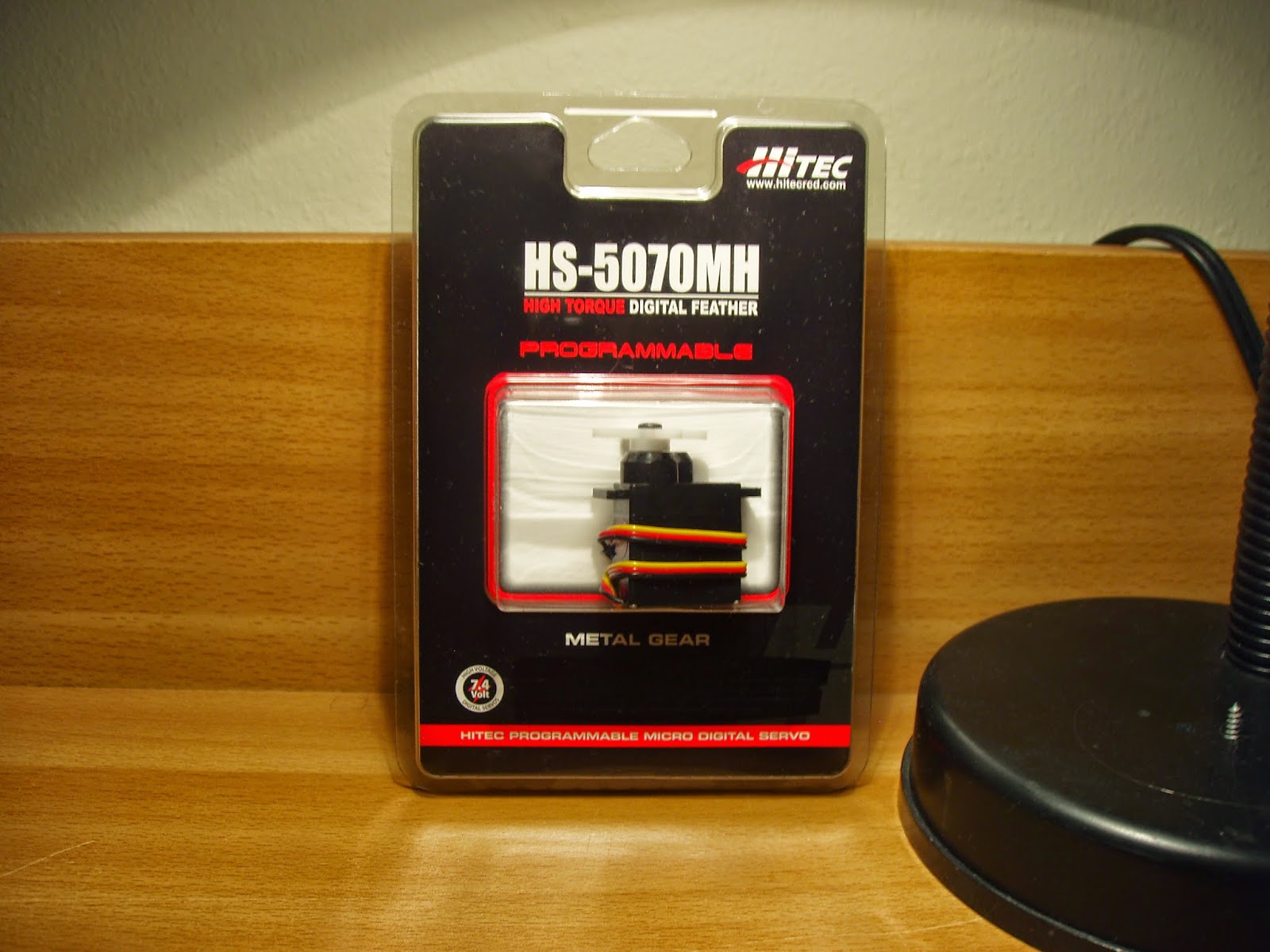
The new packaging is now adult proof, and all the servo arms and stuff are on the back side.
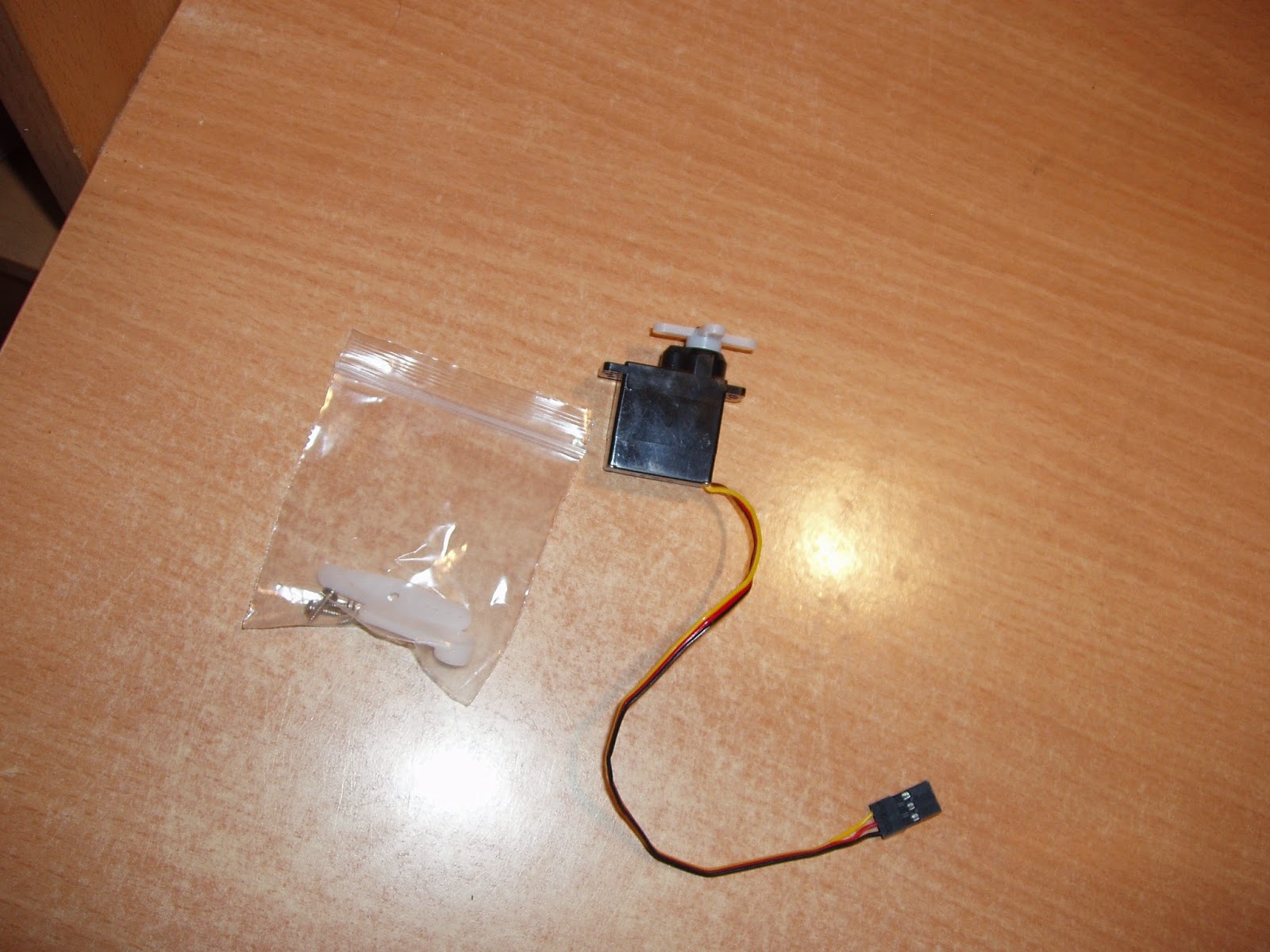
As you can see, the 5070MH uses the same servo arms and hardware as the 65MG, so you can drop these straight into your current plane if you want.
The HS5070MH does drop deeper into the airplane as you can see in the photo below. Instead of making the motor more powerful by making it bigger around (and requiring a bigger servo opening), Hi Tec got the power from making it longer. This is why the new servo sits so much taller. On some airframes, you may have to tinker with them a little to get them just right, but future EXPs will be designed for this servo to be a perfect fit.
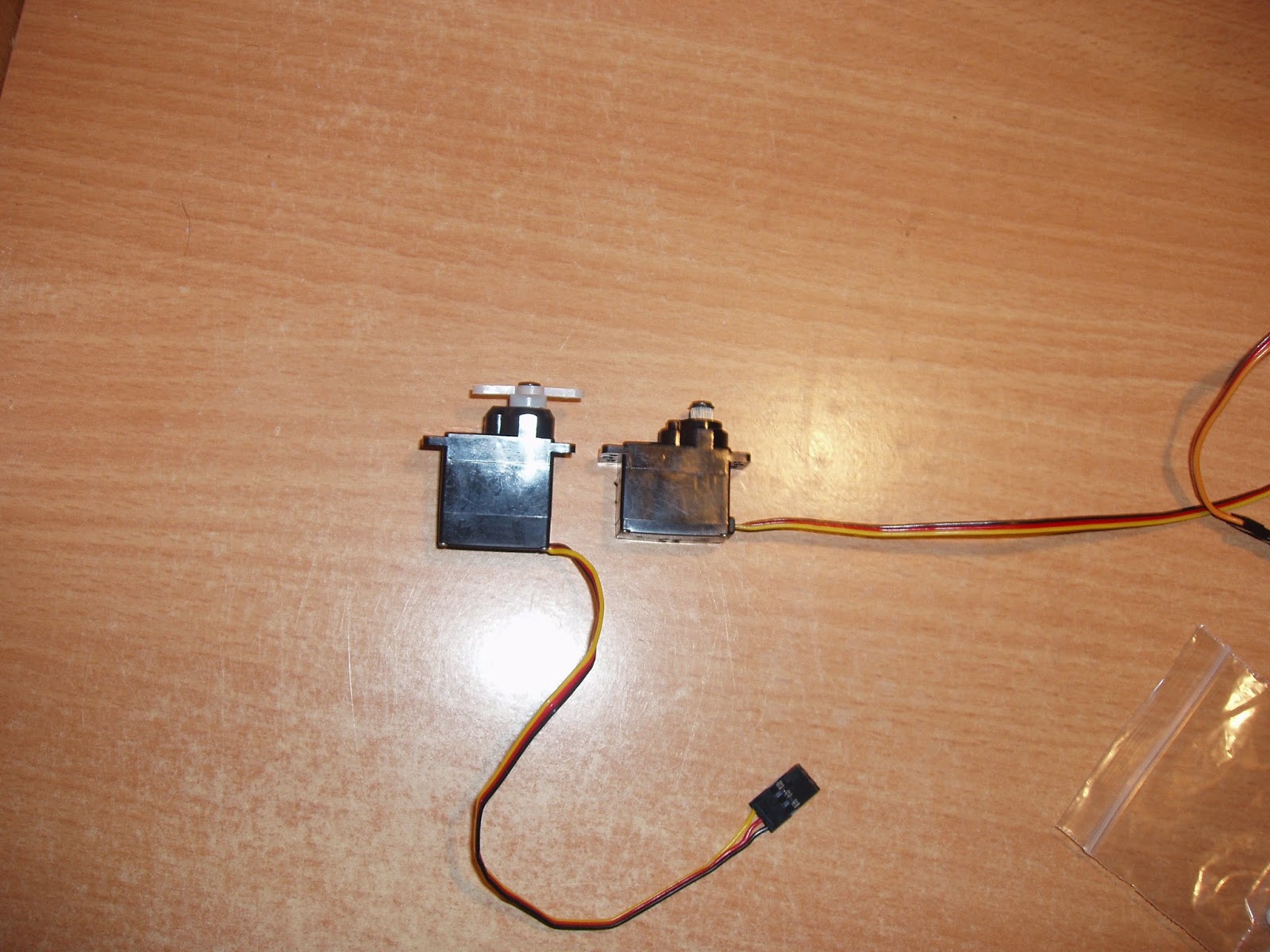
On mine, I had to put a couple of washers under the rear of the rudder servo because it is very narrow back there and the servo was bottoming out. I talked to Mike at Hi Tec and they are considering including a little plastic spacer in the hardware packs of the next production run. That would kill the problem completely, though like I say, mine just took a couple of washers.
Specifications
Motor Type: 3 Pole
Bearing Type: Top Ball Bearing
Speed (4.8V/6.0V): 0.14 / 0.12 sec @ 60 deg.
Torque oz./in. (4.8V/6.0V): 42 / 52
Torque kg./cm. (4.8V/6.0V): 3.0 / 3.7
Size in Inches: 0.92 x 0.56 x 1.11
Size in Millimeters: 23.6 x 11.6 x 28.1
Weight ounces: 0.50
Weight grams: 14.2
Set Up Pics
As you can see, you just drop the servo in and everything goes together just like it did with the HS65MG. Hi Tec pretty much provided us with a drop-in solution. If you compare these to my older Edge set up pics, you probably can't tell any difference, because outside of the servo sitting in there a little deeper, there is no difference.
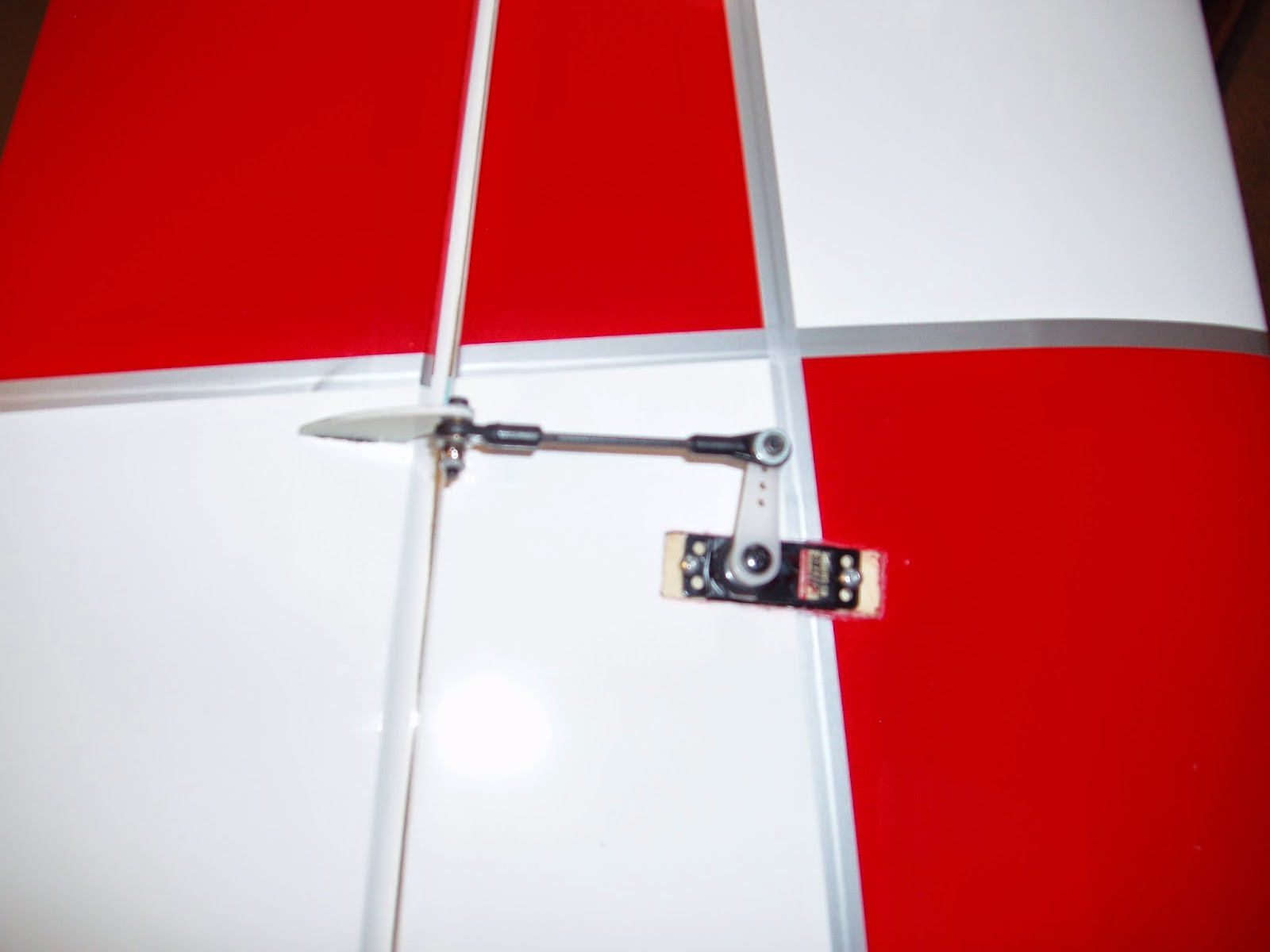
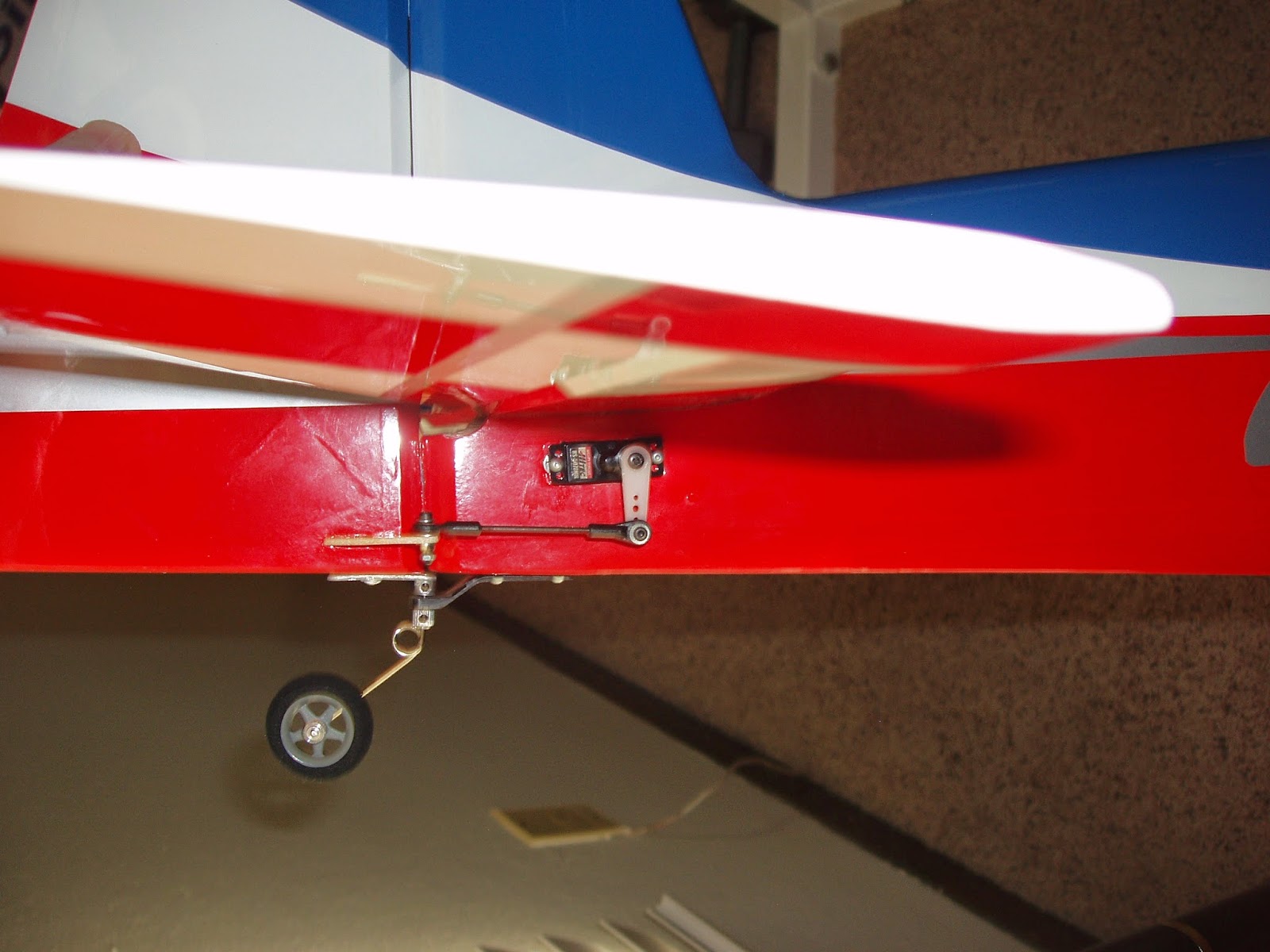
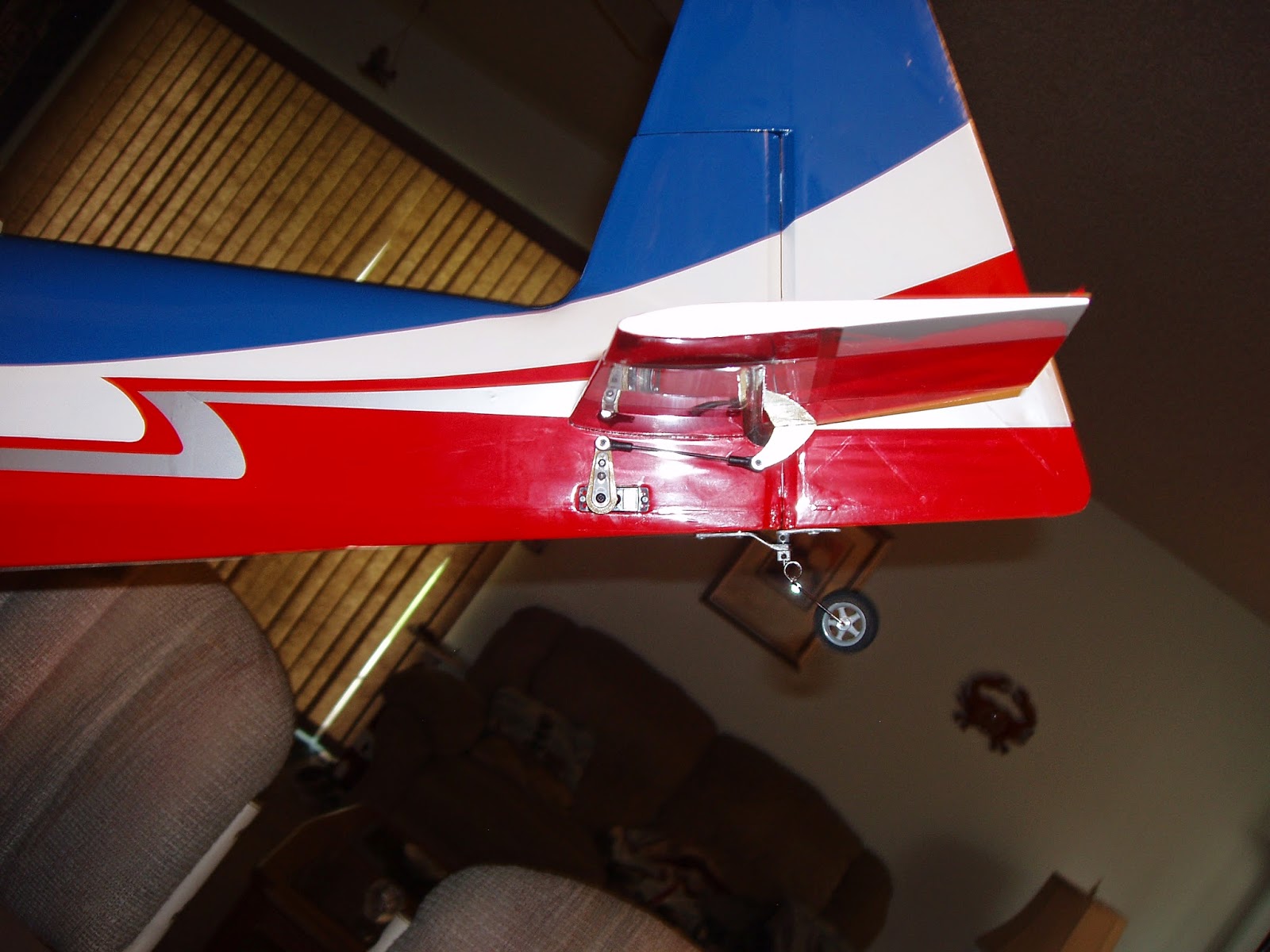
There is no 1.5" servo arm from Dubro or Hi Tec for the HS65MG or for this servo, so I used the wonderful little G10 unit that comes with the EXP kit. I have always loved this little arm and have relished a chance to try it more often.
Unfortunately it's impossible to hold the transmitter stick, the plane and throw meter and take a picture all at the same time, so you are just going to have to trust me when I tell you I measured it at 78 degrees of elevator. Previously with the HS85MG I was getting 88, but in flight I did not seem to lose any pitch authority. We need to get to the flying section before we go into any of that though.
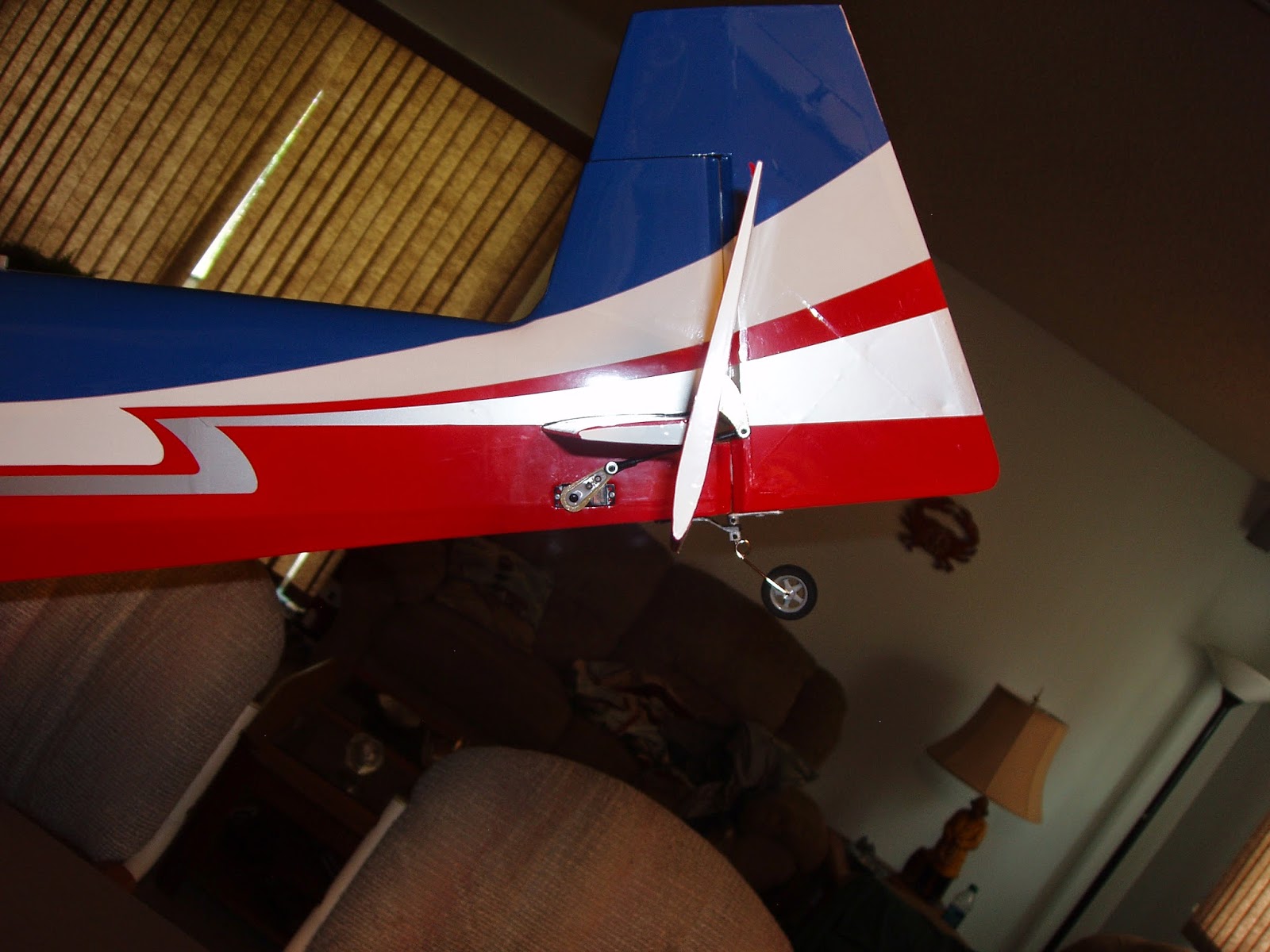
High Voltage
The biggest set up change of the whole project was switching the servos to run on 7.4volts. More voltage is more power, more speed and better centering. You will either need to find an ESC that runs 7.4 volts or run a separate BEC that does. I have always thrown a major hissy fit any time I have been required to run a separate BEC, but now that I understand them a little better this installation was not so bad. I still prefer the simplicity of having everything all in one package though.
I installed a Castle (another good company) 10 amp unit and set it at 8 volts. Damm, these little things scream their guts out on that much voltage. After flying these servos, they are so stinking solid that I don't think I need to run them that hard. I am going to turn them back to 7.4 volts to perhaps prolong their lifespan a bit.
I am also going to relentlessly badger The Boss to get us an Airboss with built in 7.4V BEC. Then, everything will be back to the plug-n-play simplicity I love so much.
I think the whole industry is going to go this direction anyway. HV servos are rapidly becoming the equipment of choice in the 60" EXP series, so it is not hard to believe we will eventually see a 7.4v Airboss for those planes too.
Holy cow. What an amazing difference. First, the plane felt pretty much the same except it rolled much quicker at high speed. I attribute this to perhaps I was getting a bit of stalling with the 65MGs. I don't generally lay the aileron stick over and keep it there for 20 seconds because I can't keep up with it, but I tried it before with a 65 equipped plane so I would have a reference. The 5070MH is much stronger here.
In fact, I believe that I was probably getting a bit of stalling with my 65s on low rates too, because I had to drop my low aileron rate down a full 7% more to achieve the three rolls in five seconds (at full deflection) rate that I like. This very much surprised me.
On the elevator the plane performs pretty much the same as my 85MG equipped Edge does, though remember this servo simply dropped into the servo opening without a single hassle. Walls and parachutes were spectacular, even though I am only getting about 78 degrees of elevator as compared to the 88 I was getting with my old set ups and the HS85MG.
I am going to need to fly the plane a bit more, but I am having a small re-think on the 88 degrees of elevator thing. I think once you get past a certain point you don't get more pitch authority, but instead more braking effect from the drag. Like I say. pitch authority with less throw was about the same, but I will need to fly the plane more and maybe tinker with it some.
Another nice benefit of the high voltage is that the servos center so well, but shockingly instantaneously. I was hitting my snap rolls much more crisply because the plane would stop right where I wanted it. Again this is something that I will have to work with a little more.
The first video was only two weeks after I got out of the hospital, so if I did not showcase the servos real well I hope that's forgivable. Below is a video we made about a month later when I was feeling much better, and also had a b it more time to get used to how the servos perform. As you can see, the plane pops really hard in walls and parachutes and snap rolls because the servos absolutely will not give even an inch.
As you can see, I went out of my way to fly the plane extremely hard and to stress the servos as much as I could. At about 2:10 I jam the plane into a full throttle waterfall almost on the deck, simply because I knew with this kind of servo torque I could get away with it. Getting braver, at 2:50 I pop a ridiculous parachute and watching the video I can't figure out what I was thinking trying it so low, other than I knew the servos and the airframe would not let me down.
When you are testing new equipment you have to remain objective and approach things in a scientific manner, but in the video you can see that I have forgotten all of that and I am just having fun pushing things as hard as I could. Having the speed and torque afforded with these servos went a long way toward the extra confidence you see here,
In the end the old reliable HS65MG and HS 85MG are still dam good servos, and I am going to use up what I have. However, anything new I build will have HS5070MH and HS5087MH servos. Since we are now in the 21st century, also any new 60" plane I build will use Hitec's excellent HS7245MH servos.
The Nail
Generally, though, I think the plane feels a bit more crisp and precise, and it's also nice the servos just drop into the existing holes. Looking forward, I think this will probably become the de rigueur servo for any serious 48" high performance plane and probably the servo all others in this size are measured against.
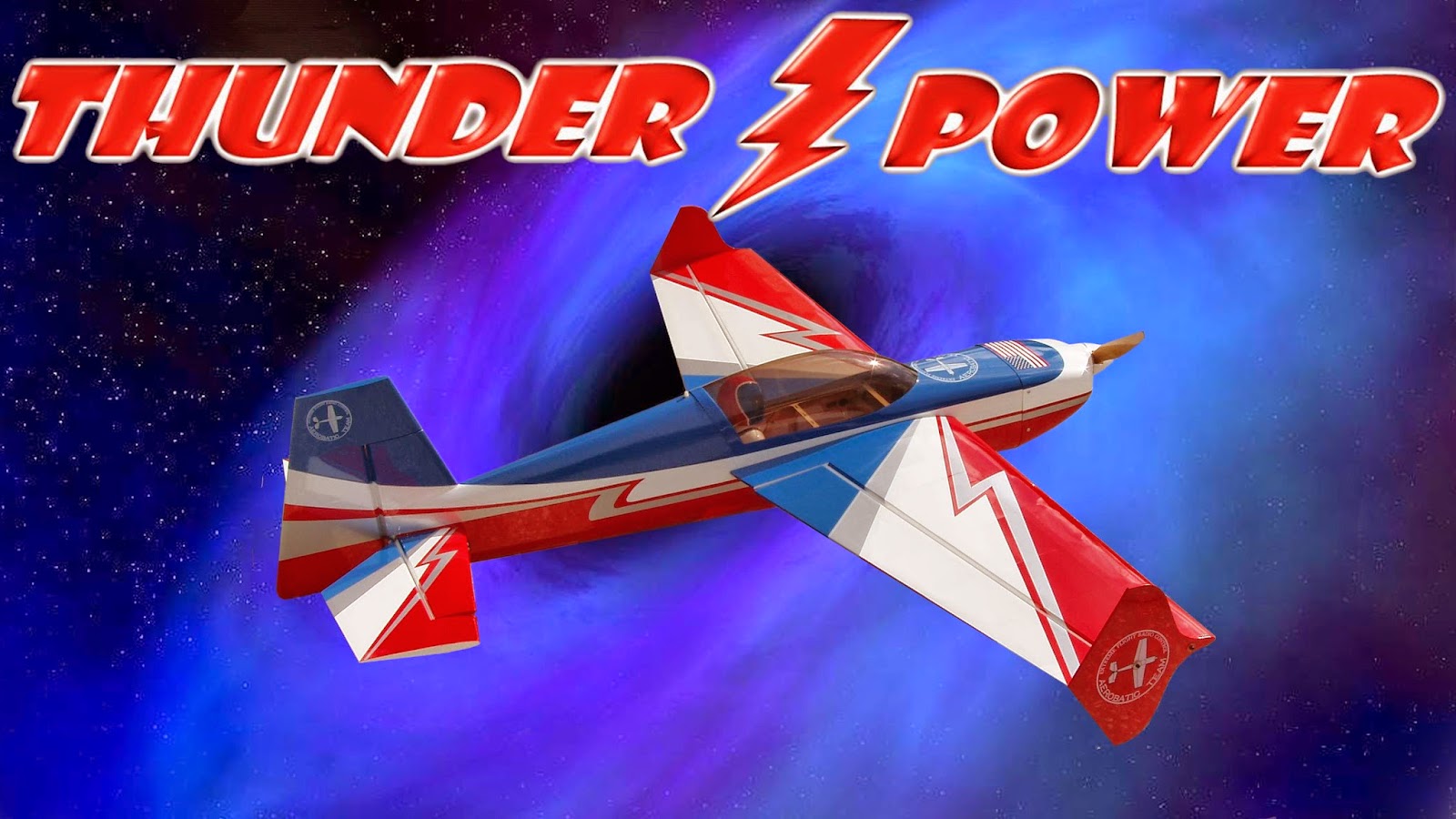

The Next Evolution
The 48" class plane seems to change and grow and preform more spectacularly every time a new airframe hits the market. I don't have the statistics, but it seems to me this is the most popular size electric (though the 60s are sure selling well). As a result, manufacturers keep updating and upgrading this class of airplane to the point that the performance is simply staggering.
First batteries got so good we needed better motors and then better ESCs, and then it was the EXP series that was the straw that broke the poor camel's back. The servos we were using had just become marginal because the airframes became so high performing.
For awhile now we have known we were on the cusp of outgrowing the beloved Hi Tec HS65MG we have been using on our 45-48 planes. Those servos served us so well for so many years, and it is still a damm good servo in it's proper application. For guys who don't relentlessly abuse the crap out of their EXPs, the 65MG will still be a good servo. It's only when you throw in the extreme abuse that the 65MG starts to suffer. For conventional aerobatics, 3D, and maybe even some lower intensity extreme aerobatics there is still nothing wrong with the 65MG at all. Also remember that the EXPs are extremely high performing airframes, and the 65MGs will still be fine in other brands of planes that do not put so much stress on the servos.
The funny part of the whole thing is the HS65MG was designed because we outgrew what we were getting from the HS55 servos, so this is a never ending cycle of airframe development being so insane that the rest of the gear struggles to keep up.
When the EXP series came out with their large control surfaces and outrageous deflections, that was the beginning of the end for the HS65MG in that application. It was simply too much plane for a servo that was not designed for that much stress. However, when the Extreme Flight Airboss ESC was upgraded to deliver 6 volts (up from 5.2), that breathed new life into those servos.
We got something like another 3.5 years out of those servos with that simple move, but even at that it was still so much stress that potentiometers were becoming scored and amplifiers were being weakened. Nothing ever failed on me, though sometimes the servos would get a little jumpy or feel mushy. Astonishingly, Hi Tec would always fix anything I sent them (except metal gears), even if it was too old to be under warranty. To me that's the mark of a pretty exceptional company.
The New Servo
Enter the Hitec HS5070MH. Boss Hinson asked Hi Tec to make us a stronger servo, but here's the hard part: it's got to fit into our existing planes. Previously some of us were cutting out the servo holes to fit HS85MGs, and believe me, that was the least fun part of the whole build. Now we have a servo that works just as well, only it drops right into the servo opening without having to modify anything.
The new packaging is now adult proof, and all the servo arms and stuff are on the back side.
As you can see, the 5070MH uses the same servo arms and hardware as the 65MG, so you can drop these straight into your current plane if you want.
The HS5070MH does drop deeper into the airplane as you can see in the photo below. Instead of making the motor more powerful by making it bigger around (and requiring a bigger servo opening), Hi Tec got the power from making it longer. This is why the new servo sits so much taller. On some airframes, you may have to tinker with them a little to get them just right, but future EXPs will be designed for this servo to be a perfect fit.
On mine, I had to put a couple of washers under the rear of the rudder servo because it is very narrow back there and the servo was bottoming out. I talked to Mike at Hi Tec and they are considering including a little plastic spacer in the hardware packs of the next production run. That would kill the problem completely, though like I say, mine just took a couple of washers.
Specifications
Motor Type: 3 Pole
Bearing Type: Top Ball Bearing
Speed (4.8V/6.0V): 0.14 / 0.12 sec @ 60 deg.
Torque oz./in. (4.8V/6.0V): 42 / 52
Torque kg./cm. (4.8V/6.0V): 3.0 / 3.7
Size in Inches: 0.92 x 0.56 x 1.11
Size in Millimeters: 23.6 x 11.6 x 28.1
Weight ounces: 0.50
Weight grams: 14.2
Set Up Pics
As you can see, you just drop the servo in and everything goes together just like it did with the HS65MG. Hi Tec pretty much provided us with a drop-in solution. If you compare these to my older Edge set up pics, you probably can't tell any difference, because outside of the servo sitting in there a little deeper, there is no difference.
There is no 1.5" servo arm from Dubro or Hi Tec for the HS65MG or for this servo, so I used the wonderful little G10 unit that comes with the EXP kit. I have always loved this little arm and have relished a chance to try it more often.
Unfortunately it's impossible to hold the transmitter stick, the plane and throw meter and take a picture all at the same time, so you are just going to have to trust me when I tell you I measured it at 78 degrees of elevator. Previously with the HS85MG I was getting 88, but in flight I did not seem to lose any pitch authority. We need to get to the flying section before we go into any of that though.
High Voltage
The biggest set up change of the whole project was switching the servos to run on 7.4volts. More voltage is more power, more speed and better centering. You will either need to find an ESC that runs 7.4 volts or run a separate BEC that does. I have always thrown a major hissy fit any time I have been required to run a separate BEC, but now that I understand them a little better this installation was not so bad. I still prefer the simplicity of having everything all in one package though.
I installed a Castle (another good company) 10 amp unit and set it at 8 volts. Damm, these little things scream their guts out on that much voltage. After flying these servos, they are so stinking solid that I don't think I need to run them that hard. I am going to turn them back to 7.4 volts to perhaps prolong their lifespan a bit.
I am also going to relentlessly badger The Boss to get us an Airboss with built in 7.4V BEC. Then, everything will be back to the plug-n-play simplicity I love so much.
I think the whole industry is going to go this direction anyway. HV servos are rapidly becoming the equipment of choice in the 60" EXP series, so it is not hard to believe we will eventually see a 7.4v Airboss for those planes too.
FLYING
[video=vimeo;102686943]https://vimeo.com/102686943[/video]
[video=vimeo;102686943]https://vimeo.com/102686943[/video]
Holy cow. What an amazing difference. First, the plane felt pretty much the same except it rolled much quicker at high speed. I attribute this to perhaps I was getting a bit of stalling with the 65MGs. I don't generally lay the aileron stick over and keep it there for 20 seconds because I can't keep up with it, but I tried it before with a 65 equipped plane so I would have a reference. The 5070MH is much stronger here.
In fact, I believe that I was probably getting a bit of stalling with my 65s on low rates too, because I had to drop my low aileron rate down a full 7% more to achieve the three rolls in five seconds (at full deflection) rate that I like. This very much surprised me.
On the elevator the plane performs pretty much the same as my 85MG equipped Edge does, though remember this servo simply dropped into the servo opening without a single hassle. Walls and parachutes were spectacular, even though I am only getting about 78 degrees of elevator as compared to the 88 I was getting with my old set ups and the HS85MG.
I am going to need to fly the plane a bit more, but I am having a small re-think on the 88 degrees of elevator thing. I think once you get past a certain point you don't get more pitch authority, but instead more braking effect from the drag. Like I say. pitch authority with less throw was about the same, but I will need to fly the plane more and maybe tinker with it some.
Another nice benefit of the high voltage is that the servos center so well, but shockingly instantaneously. I was hitting my snap rolls much more crisply because the plane would stop right where I wanted it. Again this is something that I will have to work with a little more.
The first video was only two weeks after I got out of the hospital, so if I did not showcase the servos real well I hope that's forgivable. Below is a video we made about a month later when I was feeling much better, and also had a b it more time to get used to how the servos perform. As you can see, the plane pops really hard in walls and parachutes and snap rolls because the servos absolutely will not give even an inch.
[video=vimeo;105312198]https://vimeo.com/105312198[/video]
As you can see, I went out of my way to fly the plane extremely hard and to stress the servos as much as I could. At about 2:10 I jam the plane into a full throttle waterfall almost on the deck, simply because I knew with this kind of servo torque I could get away with it. Getting braver, at 2:50 I pop a ridiculous parachute and watching the video I can't figure out what I was thinking trying it so low, other than I knew the servos and the airframe would not let me down.
When you are testing new equipment you have to remain objective and approach things in a scientific manner, but in the video you can see that I have forgotten all of that and I am just having fun pushing things as hard as I could. Having the speed and torque afforded with these servos went a long way toward the extra confidence you see here,
In the end the old reliable HS65MG and HS 85MG are still dam good servos, and I am going to use up what I have. However, anything new I build will have HS5070MH and HS5087MH servos. Since we are now in the 21st century, also any new 60" plane I build will use Hitec's excellent HS7245MH servos.
The Nail
Generally, though, I think the plane feels a bit more crisp and precise, and it's also nice the servos just drop into the existing holes. Looking forward, I think this will probably become the de rigueur servo for any serious 48" high performance plane and probably the servo all others in this size are measured against.

Bushwacker
3DRCF Moderator
Very nice. Thank you for the review Doc. Really gives me something to think about with my new 48" EF Extra 300 EXP. Should be here Monday.
